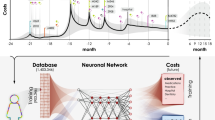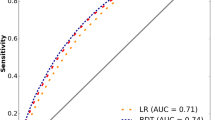Abstract
We applied and developed several machine learning techniques, including linear model, tree-based model, and deep neural networks to forecast expenditures for high utilizers in a very large public health program. The results show promise for predicting health care expenditures for these high utilizers. To improve interpretability, we quantified the contributions of influential input variables to the prediction score. These results help to advance the field toward targeted preventive care to lower overall health care costs.
Access this chapter
Tax calculation will be finalised at checkout
Purchases are for personal use only
Similar content being viewed by others
References
AHRQ: Agency for healthcare research and quality, clinical classifications software (CCS) (2015)
Ashutosh, K., Lee, H., Mohan, C.K., Ranka, S.R., Mehrotra, K., Alexander, C.: Prediction criteria for successful weaning from respiratory support: statistical and connectionist analyses. Crit. Care 20, 1295–1301 (1992)
Berk, M.L., Monheit, A.C.: The concentration of health expenditures: an update. Health Aff. 11(4), 145–149 (1992)
Blumenthal, D., Chernof, B., Fulmer, T., Lumpkin, J., Selberg, J.: Caring for high-need, high-cost patients an urgent priority. N. Engl. J. Med. 375(10), 909–911 (2016)
Chen, T., Guestrin, C.: XGBoost: a scalable tree boosting system. arXiv preprint arXiv:1603.02754 (2016)
Choi, E., Bahadori, M.T., Schuetz, A., Stewart, W.F., Sun, J.: Retain: Interpretable predictive model in healthcare using reverse time attention mechanism. In: Advances in Neural Information Processing Systems. NIPS (2016)
Choi, E., Schuetz, A., Stewart, W.F., Sun, J.: Using recurrent neural network models for early detection of heart failure onset. J. Am. Med. Inf. Assoc. (2016). doi:10.1093/jamia/ocw112
Friedman, J.H.: Greedy function approximation: a gradient boosting machine. Ann. Stat. 29, 1189–1232 (2001)
Getzen, T.: Forecasting health expenditures: short, medium and long (long) term. J. Health Care Financ. 26(3), 56–72 (2000)
Gilmer, T., Kronick, R., Fishman, P., Ganiats, T.G.: The medicaid Rx model: pharmacy-based risk adjustment for public programs. Med. Care 39(11), 1188–1202 (2001)
Harman, J.S., Lemak, C.H., Al-Amin, M., Hall, A.G., Duncan, R.P.: Changes in per member per month expenditures after implementation of Florida’s medicaid reform demonstration. Health Serv. Res. 46(3), 787–804 (2011)
Huber, C.A., Schneeweiss, S., Signorell, A., Reich, O.: Improved prediction of medical expenditures and health care utilization using an updated chronic disease score and claims data. J. Clin. Epidemiol. 66(10), 1118–1127 (2013)
Lee, R., Miller, T.: An approach to forecasting health expenditures, with application to the us medicare system. Health Serv. Res. 37(5), 1365–1386 (2002)
Margolis, R., Derr, L., Dunn, M., Huerta, M., Larkin, J., Sheehan, J., Guyer, M., Green, E.D.: The national institutes of health’s big data to knowledge (BD2K) initiative: capitalizing on biomedical big data. J. Am. Med. Inform. Assoc. 21(6), 957–958 (2014)
Minnesota Department of Health: An introductory analysis of potentially preventable health care events in Minnesota, p. 1 (2015)
Pope, G.C., Kautter, J., Ellis, R.P., Ash, A.S., Ayanian, J.Z., Ingber, M.J., Levy, J.M., Robst, J., et al.: Risk adjustment of medicare capitation payments using the CMS-HCC model. Health Care Financ. Rev. 25(4), 119–141 (2004)
Sen, B., Blackburn, J., Aswani, M.S., Morrisey, M.A., Becker, D.J., Kilgore, M.L., Caldwell, C., Sellers, C., Menachemi, N.: Health expenditure concentration and characteristics of high-cost enrollees in chip. Inquiry J. Health Care Organ. Provis. Financ. 53 (2016). doi:10.1177/0046958016645000
Srivastava, N., Hinton, G.E., Krizhevsky, A., Sutskever, I., Salakhutdinov, R.: Dropout: a simple way to prevent neural networks from overfitting. J. Mach. Learn. Res. 15(1), 1929–1958 (2014)
Stanton, M.W., Rutherford, M.: The high concentration of US health care expenditures. Agency for Healthcare Research and Quality, Washington, DC (2006)
Tibshirani, R.: Regression shrinkage and selection via the LASSO. J. Roy. Stat. Soc. Ser. B (Methodol.) 58, 267–288 (1996)
Yang, C., Delcher, C., Shenkman, E., Ranka, S.: Predicting 30-day all-cause readmissions from hospital inpatient discharge data. In: 2016 18th International Conference on E-health Networking, Application and Services (HealthCom). IEEE (2016)
Zeiler, M.D.: ADADELTA: an adaptive learning rate method. arXiv preprint arXiv:1212.5701 (2012)
Acknowledgments
This work was supported in part by Texas HHSC and in part through Patient-Centered Outcomes Research Institute (PCORI) (PCO-COORDCTR2013) for development of the National Patient-Centered Clinical Research Network, known as PCORnet. The views, statements and opinions presented in this work are solely the responsibility of the author(s) and do not necessarily represent the views of the Texas HHSC and Patient-Centered Outcomes Research Institute (PCORI), its Board of Governors or Methodology Committee or other participants in PCORnet.
Author information
Authors and Affiliations
Corresponding author
Editor information
Editors and Affiliations
Rights and permissions
Copyright information
© 2017 Springer International Publishing AG
About this paper
Cite this paper
Yang, C., Delcher, C., Shenkman, E., Ranka, S. (2017). Machine Learning Approaches for Predicting High Utilizers in Health Care. In: Rojas, I., Ortuño, F. (eds) Bioinformatics and Biomedical Engineering. IWBBIO 2017. Lecture Notes in Computer Science(), vol 10209. Springer, Cham. https://doi.org/10.1007/978-3-319-56154-7_35
Download citation
DOI: https://doi.org/10.1007/978-3-319-56154-7_35
Published:
Publisher Name: Springer, Cham
Print ISBN: 978-3-319-56153-0
Online ISBN: 978-3-319-56154-7
eBook Packages: Computer ScienceComputer Science (R0)




